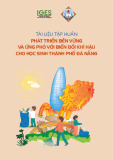
VNU HANOI UNIVERSITY OF SCIENCE
REGIONAL CLIMATE MODELING AND CLIMATE CHANGE
-----------------------------------------------------------
Phan Van Tan
phanvantan@hus.edu.vn
CƠ SỞ KHOA HỌC
CỦA BIẾN ĐỔI KHÍ HẬU
(Đại cương về BĐKH)
Phần II

B08: Biến đổi trong các thành phần hệ thống khí hậu
Bài 1: Các thành phần của hệ thống khí hậu
Bài 2: Sự truyền bức xạ và khí hậu
Bài 3: Hoàn lưu khí quyển và khí hậu
Bài 4: Bề mặt đất, Đại dương và khí hậu
Bài 5: Lịch sử và sự tiến triển của khí hậu Trái đất
Bài 6: Khái niệm về Biến đổi khí hậu
Bài 7: Tác động bức xạ và BĐKH
Bài 8: Biến đổi trong các thành phần của hệ thống khí hậu
Bài 9: Biến đổi của các hiện tượng cực đoan
Bài 10: Giới thiệu về khí hậu Việt Nam
Bài 11: Biến đổi khí hậu ở Việt Nam
Bài 12: Mô hình hóa khí hậu
Bài 13: Dự tính khí hậu
Bài 14: Xây dựng kịch bản BĐKH
Bài 15: Tác động của BĐKH và tính dễ bị tổn thương do BĐKH

Biến đổi các thành phần khí quyển
Tăng nhanh từ những năm 1950

Biến đổi các thành phần khí quyển
| CO2: was 390.5 ppm (390.3÷390.7) in 2011; è 40%
greater than in 1750 (276.4 ppm)
| N2O: was 324.2 ppb (324.0÷324.4) in 2011; è 20%
greater than in 1750 (270.00 ppb)
| CH4 was 1803.2 ppb (1801.2÷1805.2) in 2011; è 150%
greater than before 1750 (719.01 ppb).
| Hydrofluorocarbons (HFCs), perfluorocarbons (PFCs),
and sulphur hexafluoride (SF6) all continue to increase
relatively rapidly, but their contributions to radiative
forcing are less than 1% of the total by well-mixed
GHGs.

Biến đổi các thành phần khí quyển












![Tài liệu Vi sinh vật môi trường [Mới nhất]](https://cdn.tailieu.vn/images/document/thumbnail/2025/20251123/ngkimxuyen/135x160/21891763953413.jpg)
![Sổ tay truyền thông Phân loại chất thải rắn sinh hoạt trên địa bàn tỉnh Quảng Nam [Chuẩn nhất]](https://cdn.tailieu.vn/images/document/thumbnail/2025/20251114/kimphuong1001/135x160/1701763094001.jpg)


![Quản lý chất thải nguy hại: Sổ tay Môi trường [Chuẩn nhất]](https://cdn.tailieu.vn/images/document/thumbnail/2025/20251029/kimphuong1001/135x160/9011761720170.jpg)









